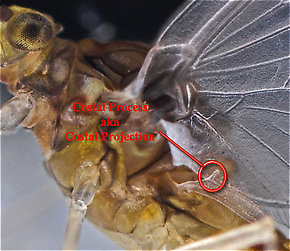Blog & Latest Updates
Fly Fishing Articles
Insects by Common Name


Mayfly Species Labiobaetis propinquus (Tiny Blue-Winged Olive)
Taxonomic Navigation -?-
Kingdom
Animalia (Animals)
» Phylum
Arthropoda (Arthropods)
» Class
Insecta (Insects)
» Order
Ephemeroptera (Mayflies)
» Family
Baetidae (Blue-Winged Olives)
» Species propinquus (Tiny Blue-Winged Olive)
Common Names
Though it has a national distribution its most important hatches occur in the West, usually hatching between the larger broods of Baetis tricaudatus. Western anglers experiencing a hatch can easily confuse them with the larger Baetis bicaudatus as both nymphs appear similar with only two tails. Besides size, the adults can be separated from bicaudatus (with the help of a little magnification) because L. propinquus lacks acute costal projections (

The costal projection of a Baetidae dun.
Where & When
Regions: Midwest, West
Time Of Year (?): Main broods in July and October
Nymph Biology
Current Speed: Fast or slow; best in slow
Substrate: Variety; best in weeds
Fred Arbona writes in Mayflies, the Angler, and the Trout that this species is found in many habitats but is only abundant in slow, weedy streams.Substrate: Variety; best in weeds
Your Thoughts On Labiobaetis propinquus:
Top 10 Fly Hatches
Top Gift Shop Designs
Eat mayflies.
Top Insect Specimens
Miscellaneous Sites
Troutnut.com is copyright © 2004-2024 Jason
Neuswanger (email Jason). See my FAQ for information about use of my images.
 privacy policy
privacy policy
